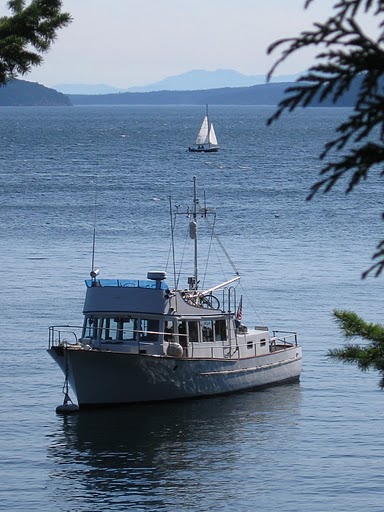AIS is a newer technology I am excited to have on board. Boats and Ships equipped with an AIS transponder will transmit information about themselves via the VHF radio frequencies. These can be picked up by anyone having an AIS receiver (or transponder). The information transmitted includes vessel ID (Name, MMSI number, size) as well as course and speed. Great technology IMHO. Larger systems (ala on ships proper) will use this information, course and speed to automatically calculate the probability of a collision, providing one more way to avoid being hit. From our side we can see a boat's actual name! This way we can hail them by name as opposed to ‘The push boat inbound at Kelly point’.
Here is a screen capture from our navigation computer (using Sea Clear software on an industrial PC running WinXP). If you look closely you will see some lime-green Boat Shaped Things. These are all plotted boats that have an AIS transponder! Clicking on one of these will pull up an information window like that one in the lower left. And as this system is based on the VHF radio technology, it means we can see boats around us for about 10 or so miles away – even around bends! Very useful on Rivers where Radar cannot see around the bend.
The AIS system has Classes of vessels. Larger craft being Class A and smaller boats being Class B. Class A systems have been required worldwide for several years now; Class B are just starting to appear in the USA. Which brings up an issue - Clutter - as AIS transponders (units that send a boats information as well as is able to receive, as opposed to receive-only units) are being adopted by pleasure craft. It is rumored that larger ships will often filter out Class B signals, and I am not sure I blame them in busy harbors. The issue will be if they do not turn off this Filter once away from the congestion. So we cannot DEPEND on a ship receiving our Class B signal. Watchful Eye needed as always! Our Class B transceiver has one feature I like: the ability to disable transmission. If you look at the screen capture, all the vessels you see are at moorage, happily announcing their presence to the world while not going anywhere! OK, so we will be able to turn off our transmitter while still being able to receive singles. Not all AIS units have this ability.
Now here is something interesting: A network of shore-based AIS receivers worldwide connected to the internet! If you click here: http://www.pdxmex.com/index.cfm?content.display&pageID=175 you will get to a web page that shows AIS traffic along the lower Columbia river. Zoom in to see detail, and more so – this system allows you to see AIS information almost anywhere in the world! A delivery Captain I talked to says he using his laptop tethered to a cell phone to get some level of AIS reception on the vessels he delivers, even if the vessel itself does not have AIS capability. What Fun.
OK. AIS, much like MMSI numbers, is one way advanced technology is being brought to the marine world. To be honest, though there are some advantages, these technologies do not replace time honored approaches to safe navigation. And for Viking Star, AIS will help us (mostly with the vessels name) to some extent – but it is only one tool..


No comments:
Post a Comment
Note: Only a member of this blog may post a comment.